fuel cap TOYOTA HIGHLANDER HYBRID 2012 XU40 / 2.G Owners Manual
[x] Cancel search | Manufacturer: TOYOTA, Model Year: 2012, Model line: HIGHLANDER HYBRID, Model: TOYOTA HIGHLANDER HYBRID 2012 XU40 / 2.GPages: 636, PDF Size: 11.26 MB
Page 2 of 636
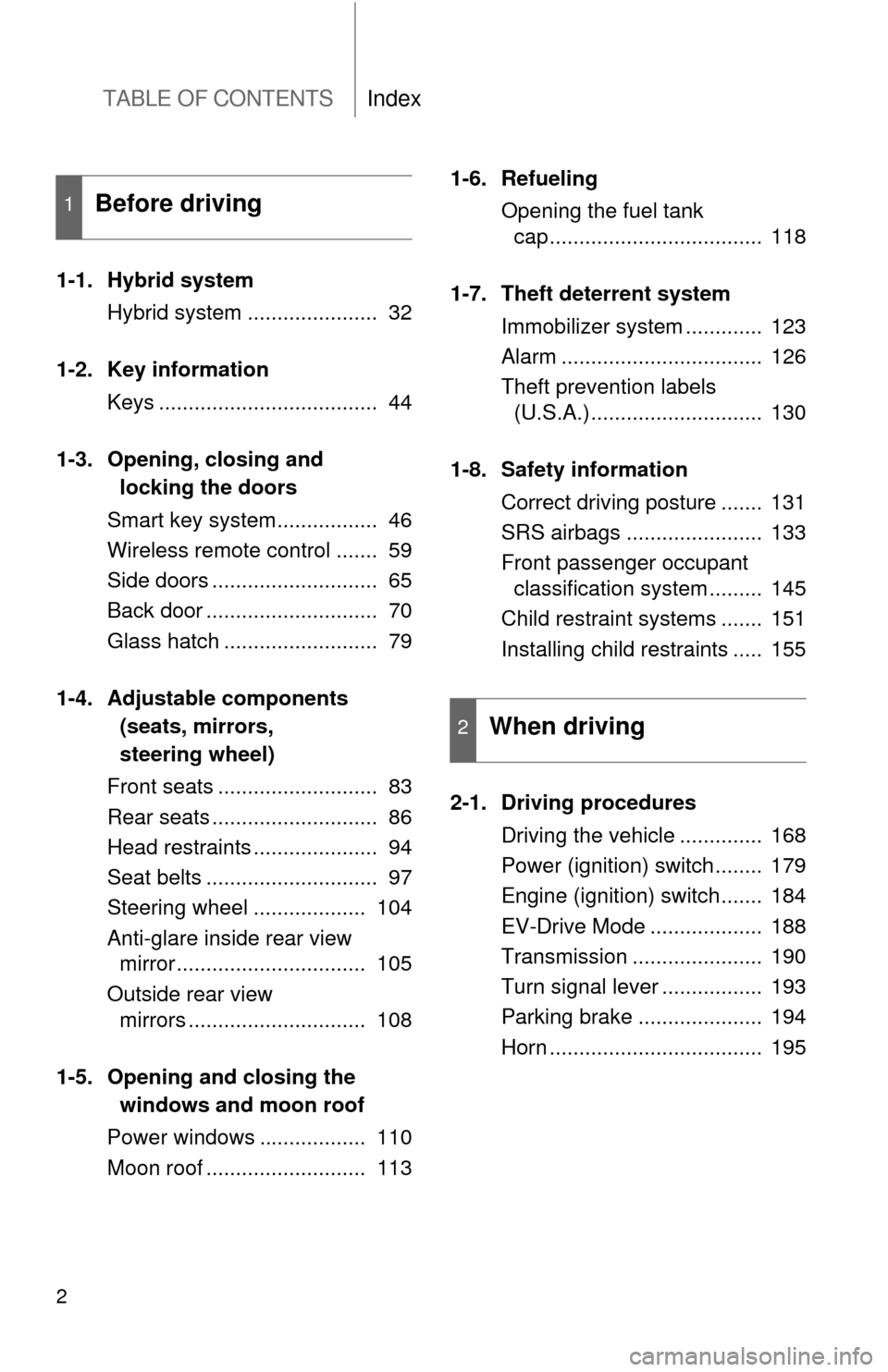
TABLE OF CONTENTSIndex
2
1-1. Hybrid systemHybrid system ...................... 32
1-2. Key information Keys ..................................... 44
1-3. Opening, closing and locking the doors
Smart key system................. 46
Wireless remote control ....... 59
Side doors ............................ 65
Back door ............................. 70
Glass hatch .......................... 79
1-4. Adjustable components (seats, mirrors,
steering wheel)
Front seats ........................... 83
Rear seats ............................ 86
Head restraints ..................... 94
Seat belts ............................. 97
Steering wheel ................... 104
Anti-glare inside rear view mirror ................................ 105
Outside rear view mirrors .............................. 108
1-5. Opening and closing the windows and moon roof
Power windows .................. 110
Moon roof ........................... 113 1-6. Refueling
Opening the fuel tank cap .................................... 118
1-7. Theft deterrent system Immobilizer system ............. 123
Alarm .................................. 126
Theft prevention labels (U.S.A.)............................. 130
1-8. Safety information Correct driving posture ....... 131
SRS airbags ....................... 133
Front passenger occupant classification system ......... 145
Child restraint systems ....... 151
Installing child restraints ..... 155
2-1. Driving procedures Driving the vehicle .............. 168
Power (ignition) switch........ 179
Engine (ignition) switch....... 184
EV-Drive Mode ................... 188
Transmission ...................... 190
Turn signal lever ................. 193
Parking brake ..................... 194
Horn .................................... 195
1Before driving
2When driving
Page 31 of 636
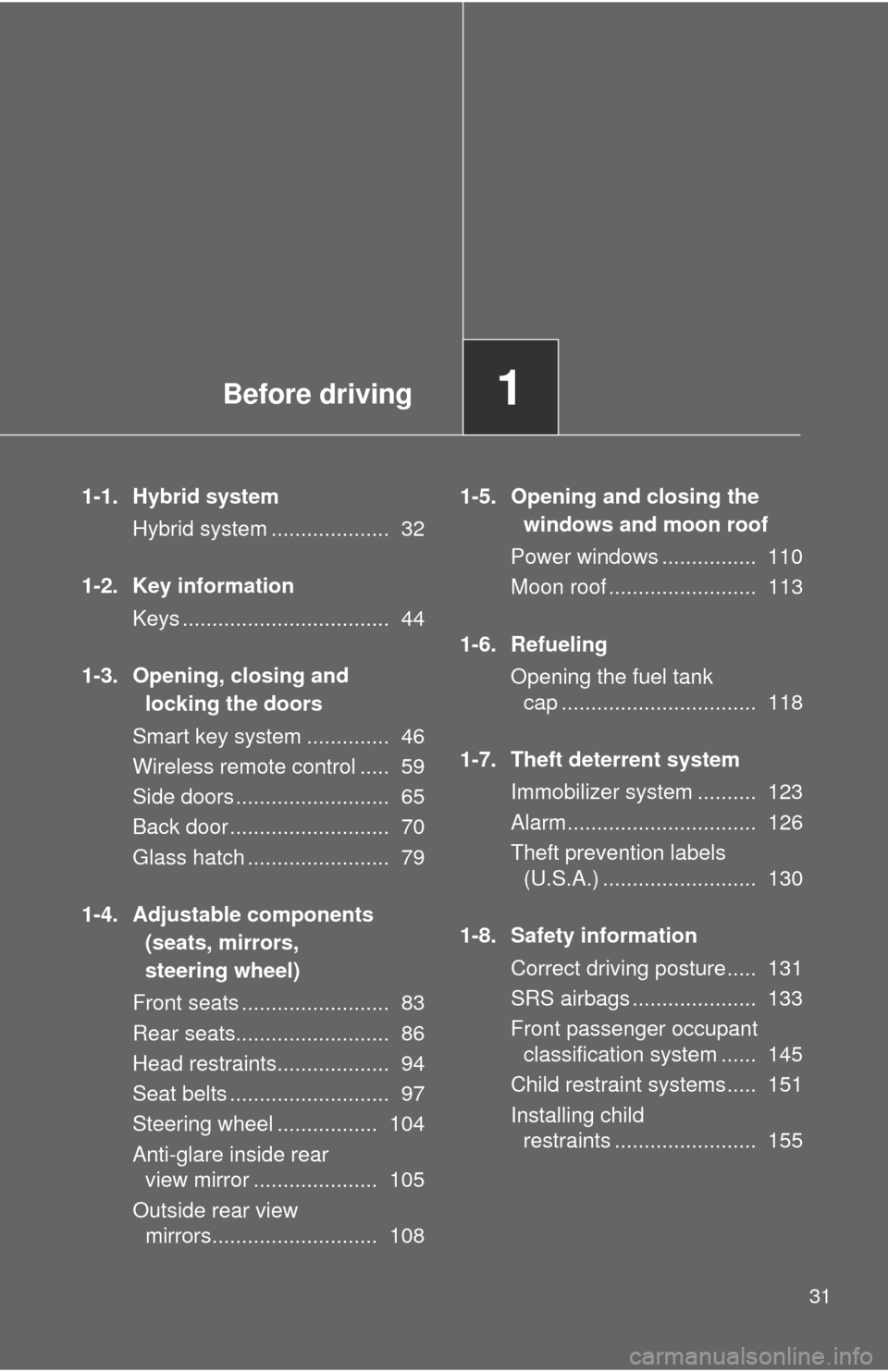
Before driving1
31
1-1. Hybrid systemHybrid system .................... 32
1-2. Key information Keys ................................... 44
1-3. Opening, closing and locking the doors
Smart key system .............. 46
Wireless remote control ..... 59
Side doors .......................... 65
Back door ........................... 70
Glass hatch ........................ 79
1-4. Adjustable components (seats, mirrors,
steering wheel)
Front seats ......................... 83
Rear seats.......................... 86
Head restraints................... 94
Seat belts ........................... 97
Steering wheel ................. 104
Anti-glare inside rear view mirror ..................... 105
Outside rear view mirrors............................ 108 1-5. Opening and closing the
windows and moon roof
Power windows ................ 110
Moon roof ......................... 113
1-6. Refueling Opening the fuel tank cap ................................. 118
1-7. Theft deterrent system Immobilizer system .......... 123
Alarm................................ 126
Theft prevention labels (U.S.A.) .......................... 130
1-8. Safety information Correct driving posture..... 131
SRS airbags ..................... 133
Front passenger occupant classification system ...... 145
Child restraint systems..... 151
Installing child restraints ........................ 155
Page 118 of 636
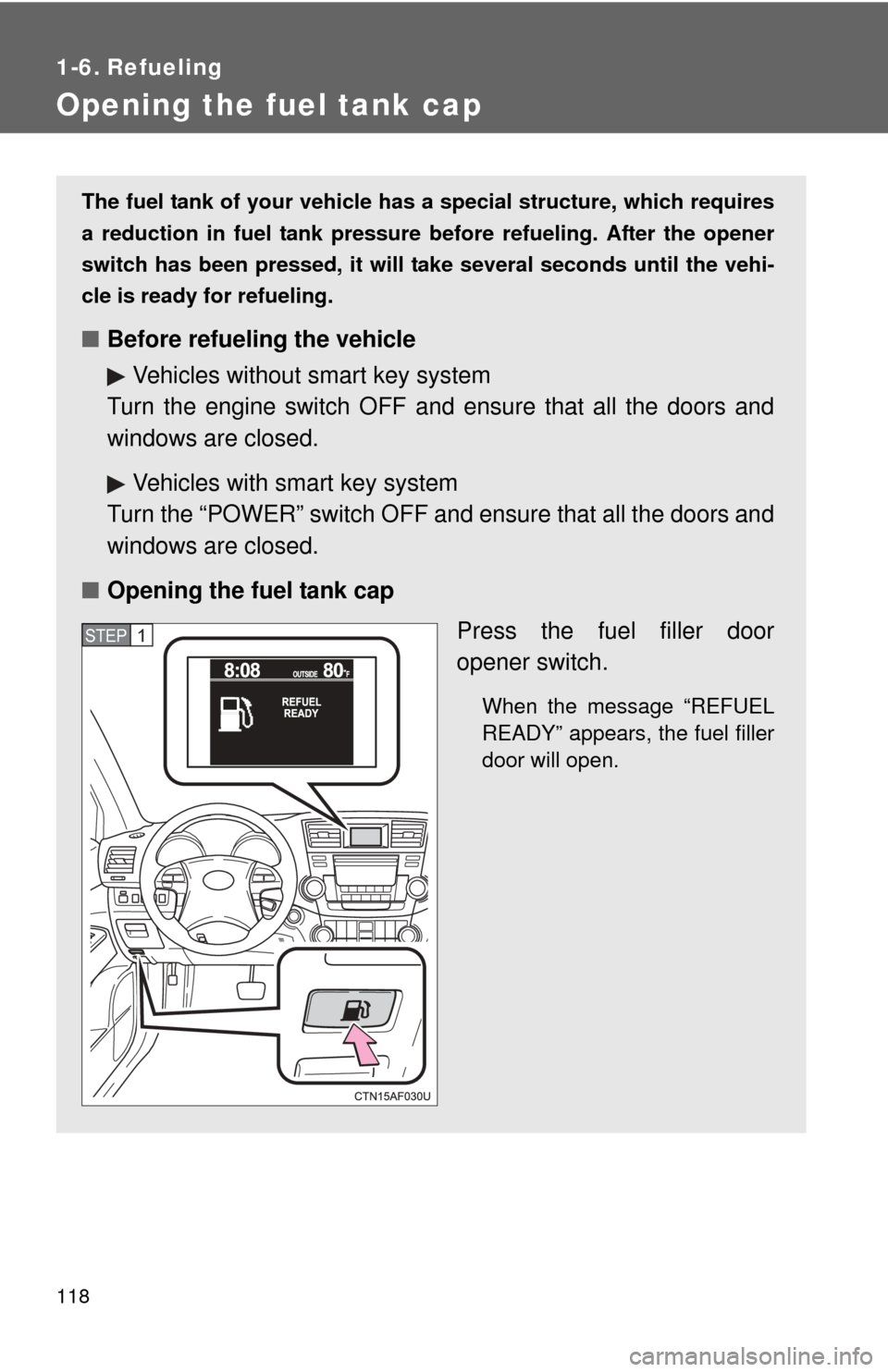
118
1-6. Refueling
Opening the fuel tank cap
The fuel tank of your vehicle has a special structure, which requires
a reduction in fuel tank pressure before refueling. After the opener
switch has been pressed, it will take several seconds until the vehi-
cle is ready for refueling.
■ Before refueling the vehicle
Vehicles without smart key system
Turn the engine switch OFF and ensure that all the doors and
windows are closed.
Vehicles with smart key system
Turn the “POWER” switch OFF and ensure that all the doors and
windows are closed.
■ Opening the fuel tank cap
Press the fuel filler door
opener switch.
When the message “REFUEL
READY” appears, the fuel filler
door will open.
STEP1
Page 119 of 636
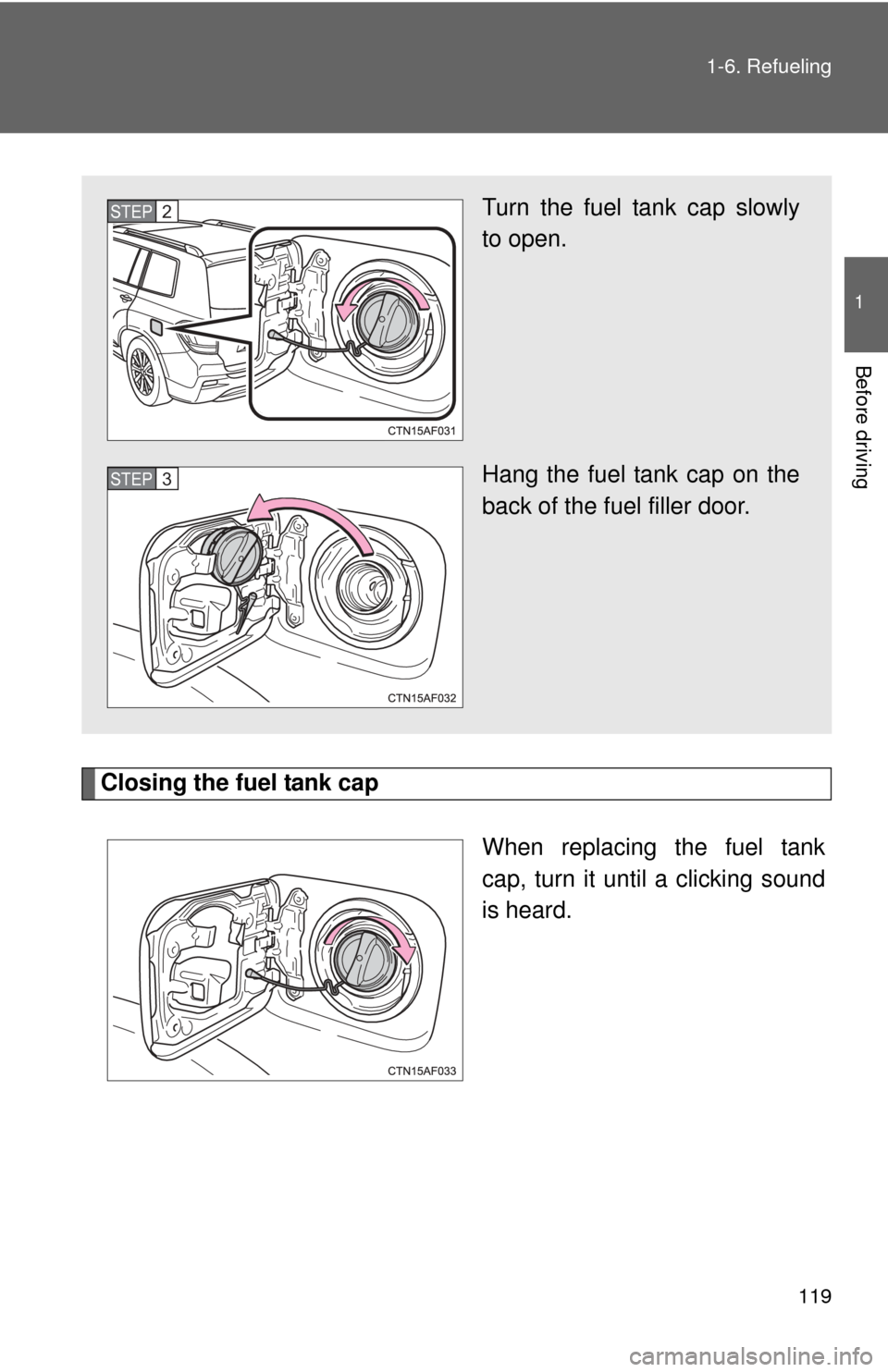
119
1-6. Refueling
1
Before driving
Closing the fuel tank cap
When replacing the fuel tank
cap, turn it until a clicking sound
is heard.
Turn the fuel tank cap slowly
to open.
Hang the fuel tank cap on the
back of the fuel filler door.STEP2
STEP3
Page 120 of 636
![TOYOTA HIGHLANDER HYBRID 2012 XU40 / 2.G Owners Manual 120 1-6. Refueling
■Fuel types
Use unleaded gasoline. (Octane rating 87 [Research Octane Number 91] or
higher)
■ Fuel tank capacity
Approximately 17.2 gal. (65.0 L, 14.3 Imp. gal.)
■ If the fuel TOYOTA HIGHLANDER HYBRID 2012 XU40 / 2.G Owners Manual 120 1-6. Refueling
■Fuel types
Use unleaded gasoline. (Octane rating 87 [Research Octane Number 91] or
higher)
■ Fuel tank capacity
Approximately 17.2 gal. (65.0 L, 14.3 Imp. gal.)
■ If the fuel](/img/14/6448/w960_6448-119.png)
120 1-6. Refueling
■Fuel types
Use unleaded gasoline. (Octane rating 87 [Research Octane Number 91] or
higher)
■ Fuel tank capacity
Approximately 17.2 gal. (65.0 L, 14.3 Imp. gal.)
■ If the fuel filler door does no t open and a “PLEASE WAIT NOW
OPENING” message appears on th e multi-information display
Fuel tank pressure is being reduced. The fuel filler door will open within
about 10 seconds of the switch being pressed.
■ If the fuel filler door opener is inoperable
If the fuel filler door opener switch cannot be operated, contact your Toyota
dealer. In the event that urgent refueling is required, follow the procedure
below.
Remove the cap slowly. Take care to prevent fuel from spilling out,
as fuel tank pressure may not have been adequately reduced.
Fill the fuel tank carefully and slowly. Use caution, as air being dis-
charged from inside the fuel tank may cause fuel to spray out from
the filler opening during refueling.
Open the fuel filler door using the lever in
the luggage compartment.STEP1
STEP2
STEP3
Page 121 of 636
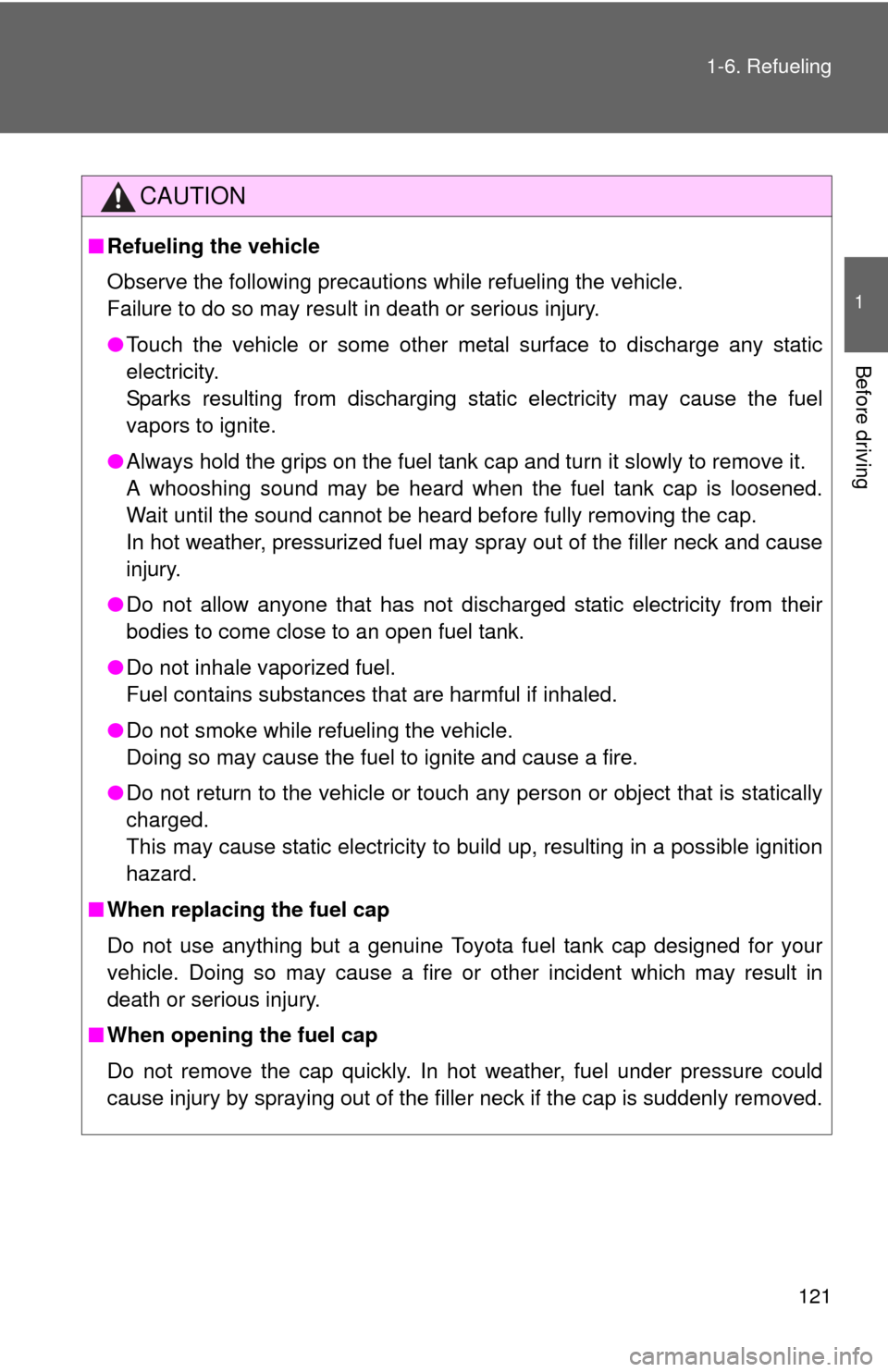
121
1-6. Refueling
1
Before driving
CAUTION
■
Refueling the vehicle
Observe the following precautions while refueling the vehicle.
Failure to do so may result in death or serious injury.
●Touch the vehicle or some other metal surface to discharge any static
electricity.
Sparks resulting from discharging static electricity may cause the fuel
vapors to ignite.
● Always hold the grips on the fuel tank cap and turn it slowly to remove it.
A whooshing sound may be heard when the fuel tank cap is loosened.
Wait until the sound cannot be heard before fully removing the cap.
In hot weather, pressurized fuel may spray out of the filler neck and cause
injury.
● Do not allow anyone that has not discharged static electricity from their
bodies to come close to an open fuel tank.
● Do not inhale vaporized fuel.
Fuel contains substances that are harmful if inhaled.
● Do not smoke while refueling the vehicle.
Doing so may cause the fuel to ignite and cause a fire.
● Do not return to the vehicle or touch any person or object that is statically
charged.
This may cause static electricity to build up, resulting in a possible ignition
hazard.
■ When replacing the fuel cap
Do not use anything but a genuine Toyota fuel tank cap designed for your
vehicle. Doing so may cause a fire or other incident which may result in
death or serious injury.
■ When opening the fuel cap
Do not remove the cap quickly. In hot weather, fuel under pressure could
cause injury by spraying out of the filler neck if the cap is suddenly removed.
Page 122 of 636

122 1-6. Refueling
NOTICE
■Refueling
●Finish refueling within 30 minutes. If more than 30 minutes passes, the
internal valve closes. In this condition, fuel may spill out if you continue to
refuel the vehicle. About 5 minutes after the valve is closed, a message
“CLOSE FUEL LID” will appear on the multi-information display. To refuel
the vehicle again, tighten the fuel tank cap and close the fuel filler door,
and then push the fuel filler door opener switch again.
● Do not spill fuel during refueling.
Doing so may damage the vehicle, such as causing the exhaust systems
to operate abnormally or damaging fuel system components or the vehi-
cle's painted surface.
Page 246 of 636
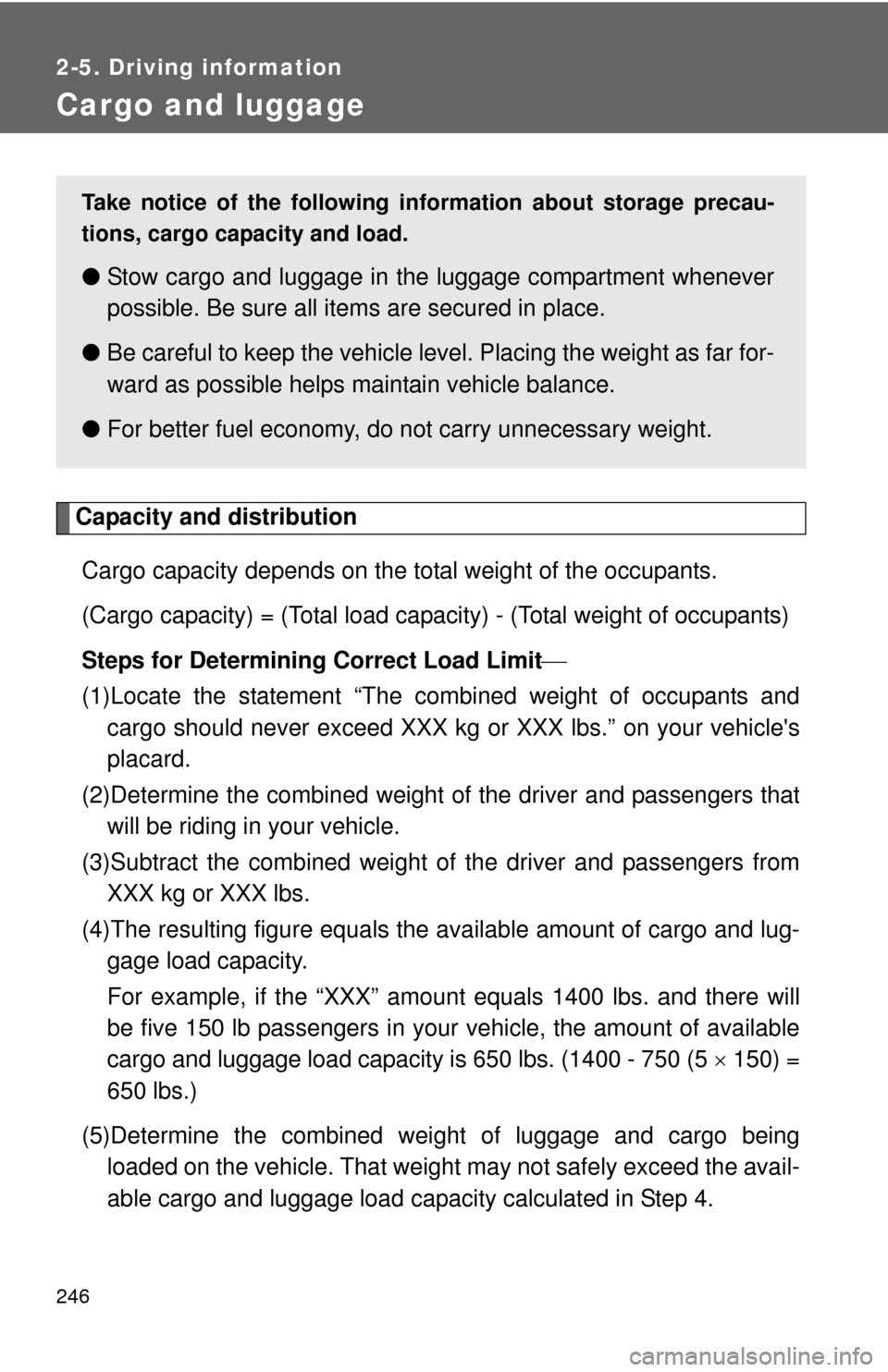
246
2-5. Driving information
Cargo and luggage
Capacity and distributionCargo capacity depends on the total weight of the occupants.
(Cargo capacity) = (Total load capacity) - (Total weight of occupants)
Steps for Determining Correct Load Limit
(1)Locate the statement “The co mbined weight of occupants and
cargo should never exceed XXX kg or XXX lbs.” on your vehicle's
placard.
(2)Determine the combined weight of the driver and passengers that
will be riding in your vehicle.
(3)Subtract the combined weight of the driver and passengers from XXX kg or XXX lbs.
(4)The resulting figure equals the available amount of cargo and lug- gage load capacity.
For example, if the “XXX” amount equals 1400 lbs. and there will
be five 150 lb passengers in your vehicle, the amount of available
cargo and luggage load capacity is 650 lbs. (1400 - 750 (5 150) =
650 lbs.)
(5)Determine the combined weight of luggage and cargo being loaded on the vehicle. That weight may not safely exceed the avail-
able cargo and luggage load capacity calculated in Step 4.
Take notice of the following information about storage precau-
tions, cargo capacity and load.
● Stow cargo and luggage in the luggage compartment whenever
possible. Be sure all item s are secured in place.
● Be careful to keep the vehicle level. Placing the weight as far for-
ward as possible helps maintain vehicle balance.
● For better fuel economy, do no t carry unnecessary weight.
Page 453 of 636
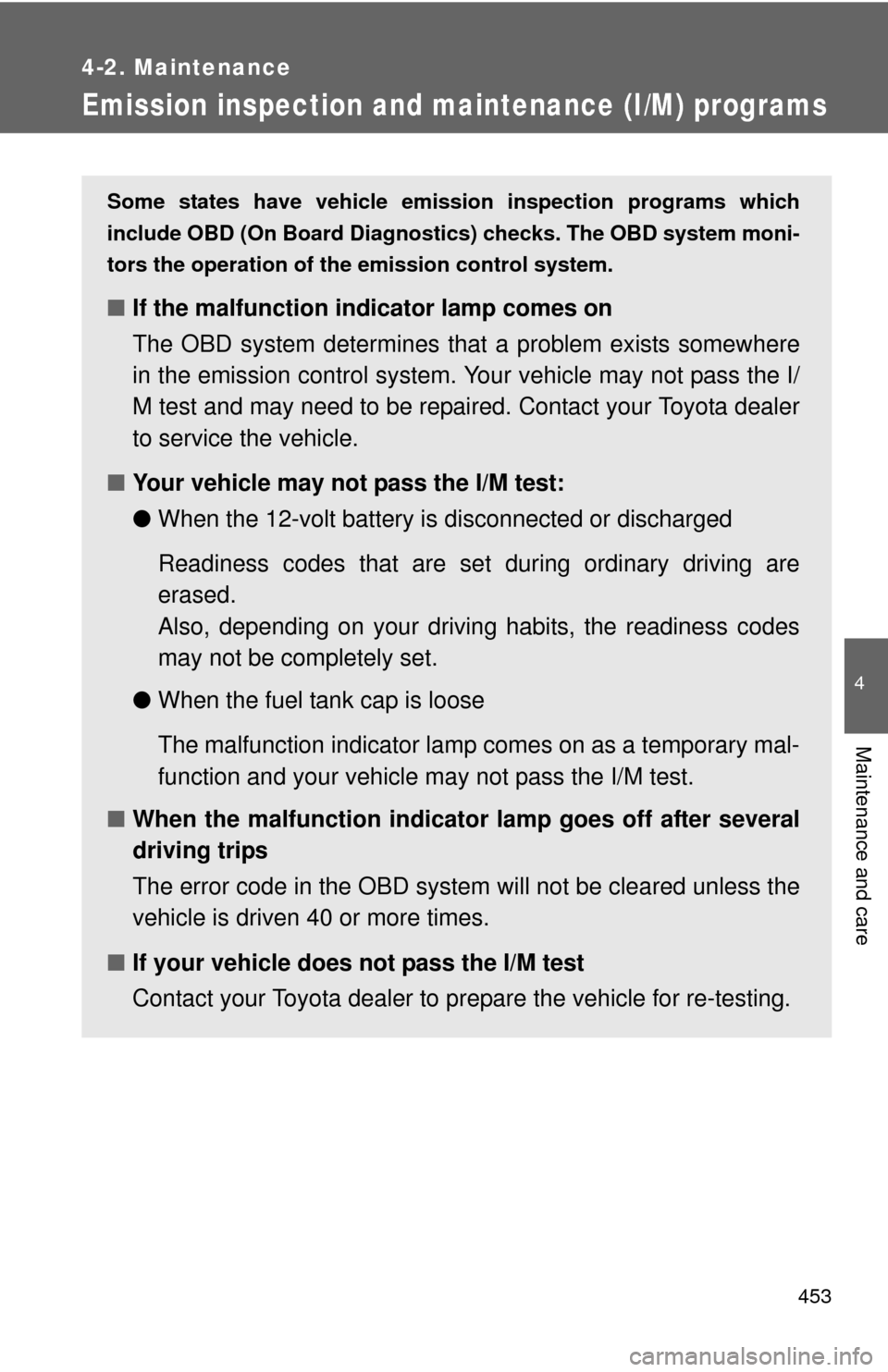
453
4-2. Maintenance
4
Maintenance and care
Emission inspection and maintenance (I/M) programs
Some states have vehicle emission inspection programs which
include OBD (On Board Diagnostics) checks. The OBD system moni-
tors the operation of th e emission control system.
■If the malfunction indicator lamp comes on
The OBD system determines that a problem exists somewhere
in the emission control system. Your vehicle may not pass the I/
M test and may need to be repaired. Contact your Toyota dealer
to service the vehicle.
■ Your vehicle may not pass the I/M test:
●When the 12-volt battery is disconnected or discharged
Readiness codes that are se t during ordinary driving are
erased.
Also, depending on your driving habits, the readiness codes
may not be completely set.
● When the fuel tank cap is loose
The malfunction indicator lamp comes on as a temporary mal-
function and your vehicle may not pass the I/M test.
■ When the malfunction indicator lamp goes off after several
driving trips
The error code in the OBD system will not be cleared unless the
vehicle is driven 40 or more times.
■ If your vehicle does not pass the I/M test
Contact your Toyota dealer to prepare the vehicle for re-testing.
Page 486 of 636
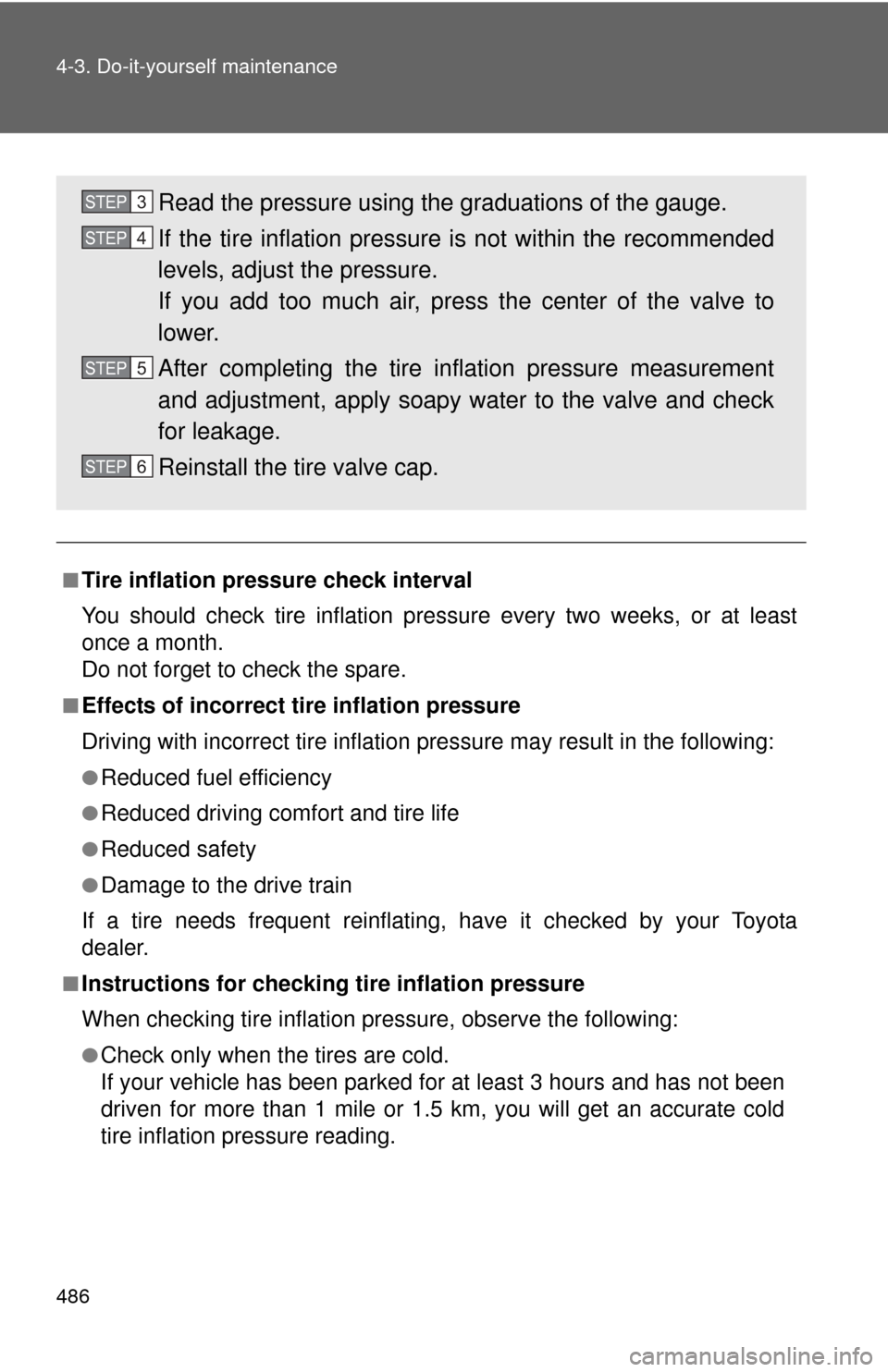
486 4-3. Do-it-yourself maintenance
■Tire inflation pressure check interval
You should check tire inflation pressure every two weeks, or at least
once a month.
Do not forget to check the spare.
■Effects of incorrect tire inflation pressure
Driving with incorrect tire inflation pressure ma y result in the following:
●Reduced fuel efficiency
●Reduced driving comfort and tire life
●Reduced safety
●Damage to the drive train
If a tire needs frequent reinflati ng, have it checked by your Toyota
dealer.
■Instructions for checking tire inflation pressure
When checking tire inflation pressure, observe the following:
●Check only when the tires are cold.
If your vehicle has been parked for at least 3 hours and has not been
driven for more than 1 mile or 1.5 km, you will get an accurate cold
tire inflation pressure reading.
Read the pressure using the graduations of the gauge.
If the tire inflation pressure is not within the recommended
levels, adjust the pressure.
If you add too much air, pres s the center of the valve to
lower.
After completing the tire inflation pressure measurement
and adjustment, apply soapy water to the valve and check
for leakage.
Reinstall the tire valve cap.STEP3
STEP4
STEP5
STEP6